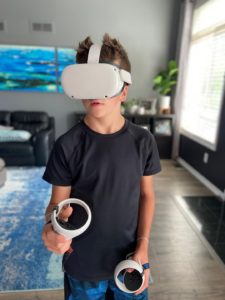What was the hottest gift this year on tweens and teens holiday wish list? As usual, technology related gifts were high in demand and many of my children’s friends asked for and received the Oculus Quest 2 Virtual Reality Headset. As a mother of three boys (ages 8-13), I sought more information on this new technology. You are not alone if you feel relatively unfamiliar with ‘immersive virtual reality technology’ I had many questions: What is it? Is it safe? Are there any long term affects? We are here to help you navigate these considerations and offer suggestions as your child uses this advanced piece of technology.
What is The Oculus Quest 2?
The Oculus Quest 2 is a virtual reality headset, recommended for ages 13 and up, which is a standalone device that fits directly onto your face and translates your movements into virtual reality. It runs games and software wirelessly under an Android based operating system., and you realistically play standing or sitting in spaces big or small.
Risks to Consider
While very little is known about the effects of immersive virtual reality on adults, there is even less knowledge on the impact of such systems on the sensorimotor abilities in young children. However, according to NeuroScience News, virtual reality affects children differently than adults. Some parents have reported that their children experienced symptoms such as motion sickness and dizziness during their VR experience. Perhaps that’s why the Oculus Quest 2 is recommended for children ages 13 and up. In the Oculus Quest 2 manual, it warns that the headset is not to be used by children under 13 years of age as it can have adverse health effects. For instance, the headset is not sized for children and improper sizing can lead to discomfort and adverse health effects when younger children are in a critical period in visual development. The company warns that even for children over 13, prolonged use can have a negative impact on coordination, balance, and multi-tasking.
As you make the decision to own and use an Oculus Quest 2, there are a few things to consider. To use the headset, you currently must connect it to a Facebook (or Meta) account, although that is a setting that the company is looking to change in the future. The headset, currently known as the Oculus Quest 2, will soon be rebranded as the Meta Quest. Most of the popular games used on the headset are available for purchase at an average price of $20.00 each.
Parents who have purchased the Oculus Quest 2 for their children have had mixed reviews on this piece of technology for their families. Some have reported that the games are a lot of fun, and they love that their child is getting exercise while playing video games, as an alternative to just sitting on the couch and staring at a screen. Some parents report that it lifts their spirits to transport themselves momentarily to a tropical beach during the dead of winter and the whole family can learn as they explore interesting and historical locations around the globe.
Another consideration is the hidden screen can make it somewhat difficult for parents to monitor the content their child is exposed to and who they are interacting with online. There are reports of use of sexually explicit language by other users while their child is involved in a virtual reality game. In that way, the Oculus Quest 2 is like other technology with an unfiltered internet browser, such as a computer or smartphone. With just a few clicks, your child can easily access an unrestricted online browser and enter a private mode of browsing that you cannot see.
As with online games or any app, there is a danger of being exposed to and targeted by online predators. By turning off the chat functions on these games, you can minimize the contact your child makes with others online.
Suggestions for Safe Use in the Home
- Have conversations with your child about the VR environment. Point out the positive and negatives to using these games.
- Engage with them and play yourself. This is one of the best ways to not only understand the games, but to develop conversation with your child and build credibility with them.
- Like all websites, games, and apps, know where your child is online and be involved. Monitor what games and content your child is downloading and being exposed to. Research the age limits, risk factors, and suggested uses for games that are being downloaded.
- Cast the headset to your TV in the family room, essentially mirroring what your child is viewing on their screen. This will allow you to better understand what types of games your child is playing and offer advice as to how to handle different situations.
- Store the headset in your bedroom, so there will not be any temptation for your child to access it during the night in the privacy of their room. Set time limits, such as 15–30-minute increments at a time.
Like most online games and apps, there are many benefits from playing games in the VR environment, but steps must be taken to reduce the risk that comes with the benefits. The goal is to provide your child the skills and knowledge to self-protect when online. It is a process and can be a long and painful one at times. However, it is a process that is critical to your children’s safety. Written by Allison Bonacci
Cyber Safety Consulting is your source of online education for schools, offering cyber safety presentations and curriculum for students, parents, teachers, and administrators nationwide. If interested in learning more about bringing this information to your organization or school community, please contact us at Allison@cybersafetyconsulting.com. For more information, please visit our website at www.cybersafetyconsulting.com.


